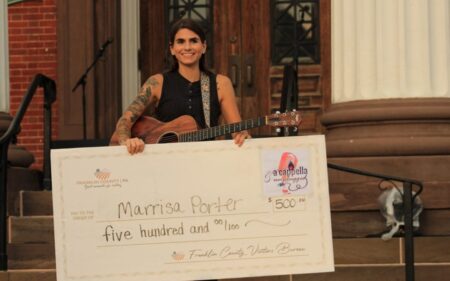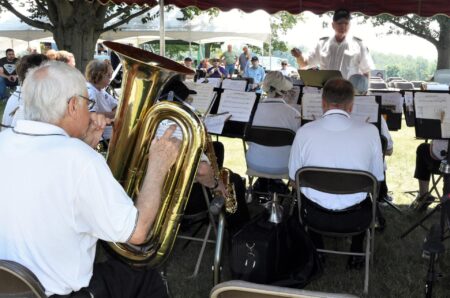EDITOR’S NOTE: If you are someone you love is struggling with substance abuse or mental health issues and are in need of treatment, please reach out. You are not alone, and help is available. 833-625-0398.
Sarah (Shank) Atencio’s path to physical fitness took an interesting turn nearly 10 years ago. Or, rather, her journey to the world of “extreme” fitness took shape one day while she was working out at a gym and was spotted “monkeying around” on the pull-up bar.
“A man approached me at the gym and said that he had noticed me monkeying around on the pull-up bar (I had just been doing dead-hangs and alternating grips) and thought that I seemed like the type of person who could become a strong athlete,” Atencio said.
That was about two months after Atencio signed up for a mud run (in 2014) – she said she went into it blind, with no special training.
She said she came to realize after the event how much upper body strength was needed and said she “majorly fell short.” Then, she said it was a personal goal of hers to do pull-ups, to lift her own body weight.
To say the rest was history would be an understatement.
Atencio’s quest–it was more of a mission–has a backstory that, at its core, was an outgrowth of her struggles with body image as a teenager.
“I struggled with an eating disorder as a teen, and I have tried to maintain fairly balanced eating habits by exercising consistently,” she said. “But, life happens, bodies change and people change. My depression declined, and I began using other substances in order to self-medicate.”
Atencio, who said she has always been into fitness–mostly weight-lifting and short-to-moderate distance running–found herself at a low point in March 2011.
“I landed in the hospital multiple times over a short span of a few months,” Atencio recalled. “I returned to where my support system was and worked to get my life back on track.
“This has not been a linear journey. There have been setbacks and side steps and plateaus.”
It turns out that Atencio’s out-of-the-blue encounter at the gym became a starting point that has helped her get to this point.
“He shared that he had started a small obstacle course in Great Falls, Virginia, for people who were into the sport of Obstacle Course Racing (OCR),” Atencio said. “I went down a few weeks later to check out the course and found my tribe. There were people from all walks of life who had found a place where they were physically and mentally challenged in an incredibly supportive environment. I didn’t even know what I needed until I found it.”
If life, as Atencio said, gets in the way, it always helps to overcome the obstacles with extremely difficult challenges – like the Spartan and Savage Race. It all ties into her deeply motivated determination that started with the Rugged Maniac (a 5-kilometer race) to 15K events with much more unforgivable obstacles.
Atencio said that the most popular races are Spartan and Savage Race.
“Savage is my personal favorite, and the one that I most frequent,” Atencio said. “Every year they create new obstacles, and every year they get more difficult.
“But I love that. There is usually one obstacle that I just cannot get, and that is where I ‘lose my band.’ For people running in competitive waves, you are given a band that you wear and can only keep if you complete the obstacle. If you do not complete one, your band is cut and you no longer qualify for a podium win.”
Atencio said she usually loses her band, and she added that the creators of the Savage race put a very difficult obstacle at the end of the six-mile course.
“Last year, I traveled to Dallas to run a Savage Race, which was the only time I had ever actually flown somewhere just to race,” she said. “It was totally worth it. I completed an obstacle I had failed every single time since it was created. I was hanging off a rope for dear life and just barely reached the bell. But, when I heard the DING, I almost cried. I had totally surprised myself.”
But in the world of extreme fitness, it’s not so easy to run before you can walk. Atencio had to learn the ropes along the way and get her body to the point where it could hold up under the demands of the obstacle courses.
“The rest of 2015 I signed up for all the OCR races within driving distance that I could afford,” she said. “I was working as an addiction counselor and was not exactly rolling in dough, and the races were costing anywhere from $80 to $150 each.
“I continued to train by doing efficient workouts that included 30 minutes of cardio (typically a HIIT circuit) followed by strength training. And, of course, every few weekends I would drive down to the OCR Unleashed course in Great Falls to get some actual obstacle work in.”
Atencio began to notice some good changes going on in her body that would help her increase her workload – and payload.
“I found that all that upper body training and anything that involved holding my own weight was majorly changing my body composition,” she explained. “I was getting more muscular, and my weight was dropping. It became pretty easy to maintain m weight with that level of training, which is what I had been looking for most of my life.”
Atencio said she aspired to be good enough to qualify for the OCR World Championships, noting the qualification requirements for each race.
“I have never been a fast runner,” she said. “I knew that if I had any chance of qualifying it would have to be on a short course. I went back to my first race, the Rugged Maniac, and scored a fourth-place finish, which made me a qualifier for the 2016 World Championships.”
Atencio, a 2005 graduate of Waynesboro Area Senior High School, traveled to Canada in the fall of that year to face what she called a mountainous 15-kilomter course.
“It was brutal,” Atencio said. “I didn’t think I was going to finish, and I could barely walk afterwards. But I made it; I earned that medal.”
The following few years Atencio had what she described as “life events” that kept her from racing. She did not qualify or attend the World Championships in 2017 and couldn’t afford to travel to where the race was being held in 2018.
“In 2018 I had my second reconstructive foot surgery to correct an issue I’ve had since birth; and in 2019 I gave birth to my daughter in April. I’ve had significant trouble with my right foot for many years, many years and have constant pain. Running is painful, and I have to wear a brace. I am not fast, and I will likely never be fast. I have screws and a plate in my foot and will likely need another surgery at some point.”
The year 2020 was forgettable in that it was the year COVID-19 sidelined just about everything and everyone. All events were canceled in 2020.
When the world opened for business in 2021, Atencio traveled to Vermont to face another mountain race. To her dismay, the event was open to all who wanted to compete.
“I was so mad that I had worked so hard and would be running with people who didn’t have to qualify,” Atencio said. “But that was a pretty closed-minded perspective. I want them to be able to afford an incredible event, so I understand them making the decision. They did what was in the best interest of the sport and the OCR community.”
Atencio is pre-registered for this year’s Vermont race.
What is perhaps just as remarkable as Atencio’s attention to the details of the grueling physical nature of obstacle course competition is that she is also the clinical director of a rehabilitation center in Gaithersburg, Maryland and is a single mother of two children.
“If I was not a single mother of two with a demanding job, I would train daily and do a race every weekend,” she said. “I know people who do 30. I envy them. I would love to travel all over the country, maybe even the world, to try all the OCR races that exist.
“For me, the sport has been something that keeps me fit, challenges me, keeps me motivated and gives me a sense of accomplishment.”
Atencio embraces the challenges in her life, even though the intensity of her workouts has been less than in previous years.
“I usually do 20 minutes of cardio followed by strength training – and I never skip a set of pull-ups. I do a longer run once every week or two, depending on time and childcare.”






















